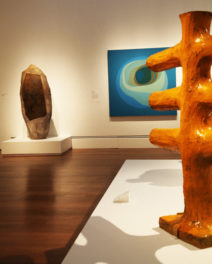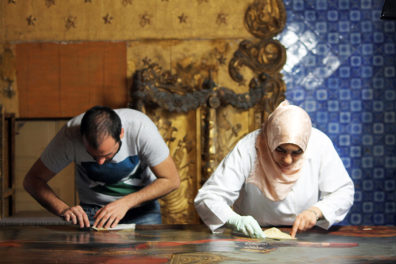
Leslie Rainer, GCI senior project specialist, working on América Tropical
América Tropical, the only surviving public mural by David Alfaro Siqueiros in the United States, is one step closer to being on view to you and me. At El Pueblo Historic Monument in downtown Los Angeles, project leaders today broke ground on a new protective shelter for the Siqueiros mural, as well as a public viewing platform and an interpretive center that will showcase the mural’s storied history.
The $8.95 million public-private investment—a $3.95-million commitment from the Getty as well as $5 million from the City of Los Angeles—is the culmination of years of effort to showcase América Tropical.
The event made news headlines—but what you didn’t see in the news is that Getty Conservation Institute conservators have already been hard at work planning and carrying out the mural’s extensive conservation treatment.

Siqueiros, one of the great Mexican muralists of the 20th century, painted América Tropical in 1932 on the second story exterior wall of the Italian Hall.
Controversial from the start, the mural—which depicts a crucified Mexican Indian with an American eagle, talons extended above his head, and two revolutionary soldiers closing in from the right, one aiming at the eagle—drew praise for the power of the image. But it also outraged the city’s civic leaders for its political and social content.

Siqueiros’ assistant Robert Bredecio in front of América Tropical, before it was whitewashed
Within months, the section of the mural visible from Olvera Street, which included the soldiers, was painted over, and within the decade the entire mural was completely whitewashed. It was virtually forgotten until the 1960s, when the rise of the Chicano mural movement brought renewed interest in América Tropical.
Due to that early whitewashing and ongoing exposure to the elements, the mural has suffered badly. Its colors have faded, and in places, plaster has fallen away to expose the wall underneath.
The GCI team has given the mural a thorough cleaning, reattached some of that plaster, and stabilized the piece. Scientists have conducted non-damaging technical studies to identify the materials originally used by Siqueiros to create the extraordinary mural, which were never documented. It’s interesting and important, but not easy, work.
In addition to managing the complex technical aspects of the conservation, the project team must also manage the expectations of the public, arguably the more difficult task. The GCI has conserved the Siqueiros mural so that it can be seen by the public without further damage, but the work is being conserved, not restored—which in simple parlance means that conservators won’t repaint the mural.
In a world where we expect flash and vibrancy, where attention spans are short, this goes against the grain. The reasons for this type of conservation (versus restoration) are many: current conservation practice, a strong desire to preserve the artist’s hand, and a team that is loathe to speculate about what Siqueiros might have wanted today.
“We just don’t know what the colors looked like so, we would be guessing and potentially misrepresenting the artist’s choice of colors and therefore his work,” shared Susan MacDonald, head of GCI Field Projects.
You’d be surprised how often these kinds of issues arise in conservation. (See The Object in Transition for more discussion of this topic.)
It’s wonderful that the shelter, viewing platform, and interpretive center, when completed in roughly two years, will finally allow the citizens of Los Angeles and beyond to see this key work of art by one the great Mexican muralists of the 20th century, a work that hasn’t been visible in its entirety since 1932.
It’s true that the mural will never be as vibrant as it was when first painted by Siquerios. Still, the artistic, historic, and social significance of América Tropical to Los Angeles remains undiminished. Siqueiros’ vision—and his hand—will again be visible to future generations. And that’s what conservation is all about.




Let the decrepid mural go. Use the cash for something important. I imagine D.A.S. would agree.
“It’s true that the mural will never be as vibrant as it was when first painted…” Are you kidding? It is barely visible! And for that outcome an investment of years and millions of dollars – shouldn’t an accounting be part of the public record for a project like this involving the city and a non-profit? – for a shelter, viewing stand and – where would we be without them – an interpretive center for everyone, if there is anyone, to glance at as they walk by. Conservation, indeed.
Thanks for your comment. The mural will never be as vibrant as it was when it was first painted, but we don’t need the originally vibrant colors to convey the importance of this mural in the history of the city and in the context of Siquieros’ career.
Excellent post. I absolutely appreciate this website. Thanks!